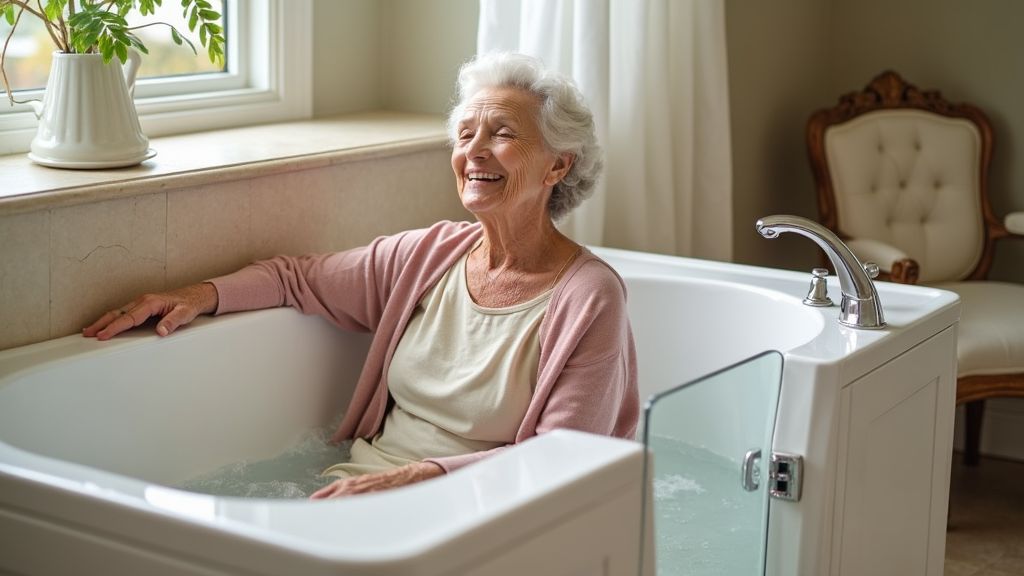For many seniors, the promise of safety and independence lies within the embrace of a walk-in tub. But can Medicare help you foot the bill for this essential feature? Let’s wade through the details and discover what coverage possibilities are available.

Understanding the Importance of Walk-In Tubs
Walk-in tubs have become a beacon of safety and convenience for countless elderly and disabled individuals. These tubs are designed with a small door on the side, allowing easy entry and minimizing the risk of slips and falls—a common concern in traditional bath spaces. For seniors like Margaret, who cherishes her independence but struggles with mobility, a walk-in tub can transform a daily challenge into a comfortable ritual. Injuries in the bathroom are not uncommon among seniors; in fact, they account for a significant percentage of home accidents. Walk-in tubs provide not just comfort but peace of mind, offering features like built-in seating, handrails, and anti-slip flooring. But while the benefits are substantial, so too is the potential cost, which may lead individuals to seek financial assistance.
The Myth of Medicare Coverage: Setting the Record Straight
There’s a common misconception among seniors that Medicare will readily cover the cost of a walk-in tub. In reality, the situation is a bit more complex. Traditional Medicare Parts A and B do not typically cover walk-in tubs, classifying them under the umbrella of non-essential or luxury items. This can be disappointing news for someone like Harold, who believed his Medicare plan would alleviate the financial burden of attaining a safer bathing option. However, there are exceptions. If a doctor prescribes a walk-in tub as medically necessary equipment, Medicare Advantage Plans might provide partial coverage. Even then, securing this coverage often involves navigating a maze of paperwork and waiting for approvals, which can deter many from pursuing this avenue.
Exploring Alternative Avenues: Financial Assistance Options
When Medicare falls short, hope isn’t lost. Numerous alternative financial assistance options can ease the cost burden of walk-in tubs. Medicaid, for example, varies by state but might offer some coverage under its Home and Community-Based Services (HCBS) waivers if the tub is deemed necessary to maintain independence at home. Moreover, veterans like Robert may find help through the Department of Veterans Affairs, which offers grants for home modifications to make spaces more adaptable and safe. There are also non-profit organizations dedicated to assisting seniors in modifying their homes to suit changing mobility needs, funded by grants aimed at fostering safer living environments for the elderly.
Personal Stories: How Seniors Have Found Support
The journey to securing a walk-in tub can be challenging, but it’s not insurmountable. Take the story of Alice, a determined widow who, facing the prohibitive costs, sought assistance from a local senior advocacy group. Through their guidance, Alice discovered a state-funded grant that covered a significant portion of her tub's cost. Meanwhile, Jim, a brave army veteran, leveraged both his VA benefits and Medicare Advantage plan to fund his walk-in tub—an investment that he says has dramatically improved his quality of life. These personal stories illuminate the path forward for countless others navigating similar waters, emphasizing the importance of persistence and resourcefulness.
Strategizing for the Future: Navigating Healthcare Costs
As seniors and their families consider the potential need for walk-in tubs, planning becomes paramount. Starting the conversation early can pave the way to identify and apply for eligible programs and financial assistance. Understanding each person's specific healthcare needs and reviewing current insurance plans can reveal gaps that might be filled by additional coverage options, or alternative financial strategies. In this dynamic healthcare landscape, having conversations with healthcare providers, keeping informed about state benefits, and being proactive in applications are crucial steps. It’s also wise to engage with financial planners who specialize in elder care, ensuring all possible resources are explored. While Medicare may not be the catch-all solution for walk-in tub costs, armed with the right knowledge and resources, seniors can still secure the safety and comfort they richly deserve.